The Second-Generation "Hip"
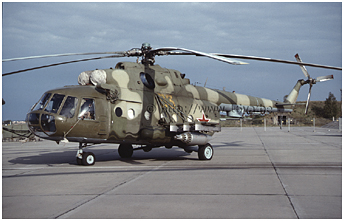
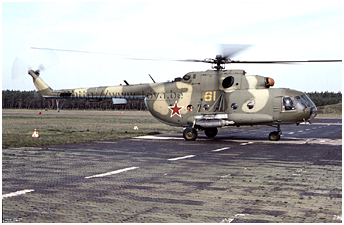 The first studies to improve the Mi-8 airframe already began in 1964. In addition to increasing the carrying capacity, it was also a matter of improving
performance at high altitudes. However, due to the development of other helicopters such as the amphibious Mi-14 or the Mi-24, it was not until August 17, 1975 that the prototype
of the improved Mi-8 made its first flight. The need for such a helicopter was then acute, because the Mi-4 whose performance at high altitudes was superior to that
of the Mi-8T was then being phased out.
This new version was initially called Mi-8M, and then Mi-8MT (MT for Modernizerovannyy Transportnyy - Modernized Transport) "Hip-H."
Its performance was superior thanks to the new Isotov TV3-117MT turbines (1) rated at 1900hp associated with the
Mi-14 VR-14 gearbox with a reinforced transmission chain.
The first studies to improve the Mi-8 airframe already began in 1964. In addition to increasing the carrying capacity, it was also a matter of improving
performance at high altitudes. However, due to the development of other helicopters such as the amphibious Mi-14 or the Mi-24, it was not until August 17, 1975 that the prototype
of the improved Mi-8 made its first flight. The need for such a helicopter was then acute, because the Mi-4 whose performance at high altitudes was superior to that
of the Mi-8T was then being phased out.
This new version was initially called Mi-8M, and then Mi-8MT (MT for Modernizerovannyy Transportnyy - Modernized Transport) "Hip-H."
Its performance was superior thanks to the new Isotov TV3-117MT turbines (1) rated at 1900hp associated with the
Mi-14 VR-14 gearbox with a reinforced transmission chain.
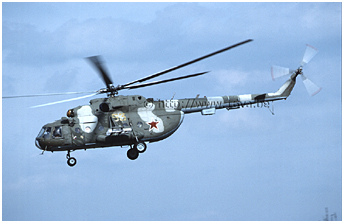
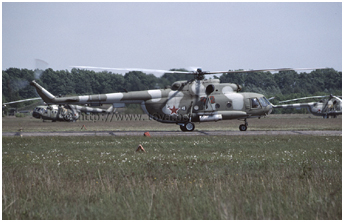 One of the most notable external changes of this new "Hip" version was the displacement of the
anti torque rotor to the left side, the latter becoming "tractor" instead of "pusher," which provided better yaw control.
The Mi-8M turbine fairings were shorter and an Ivchenko AI-9V auxiliary power unit used to start the turbines was located perpendicularly behind the main rotor (air intake on
the right side and exhaust on the left side). The turbine air intakes were - most of the time - protected by semi-cylindrical shaped PZU
(Pylezashchitnoe Ustroystvo - dust protector) filters.
The second-generation Mi-8s were - and still are - commonly misnamed Mi-17 in the west, this designation actually referring to the export model
Series production of the Mi-8MT began at the Kazan' plant in 1977.
Like the Mi-8T, the Mi-8MT could be equipped with standard or larger capacity fuel tanks as mentioned in the first part of this chapter - although the latter
were not observed on Mi-8MT in the GDR. The injection of inert gas protected them against a possible explosion. Also, it of course remained possible to carry additional
fuel tanks inside the cargo hold and this helicopter like the Mi-8T could be converted to carry stretchers.
One of the most notable external changes of this new "Hip" version was the displacement of the
anti torque rotor to the left side, the latter becoming "tractor" instead of "pusher," which provided better yaw control.
The Mi-8M turbine fairings were shorter and an Ivchenko AI-9V auxiliary power unit used to start the turbines was located perpendicularly behind the main rotor (air intake on
the right side and exhaust on the left side). The turbine air intakes were - most of the time - protected by semi-cylindrical shaped PZU
(Pylezashchitnoe Ustroystvo - dust protector) filters.
The second-generation Mi-8s were - and still are - commonly misnamed Mi-17 in the west, this designation actually referring to the export model
Series production of the Mi-8MT began at the Kazan' plant in 1977.
Like the Mi-8T, the Mi-8MT could be equipped with standard or larger capacity fuel tanks as mentioned in the first part of this chapter - although the latter
were not observed on Mi-8MT in the GDR. The injection of inert gas protected them against a possible explosion. Also, it of course remained possible to carry additional
fuel tanks inside the cargo hold and this helicopter like the Mi-8T could be converted to carry stretchers.
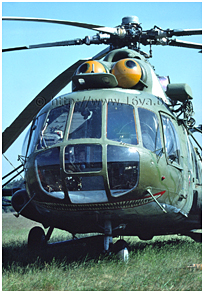
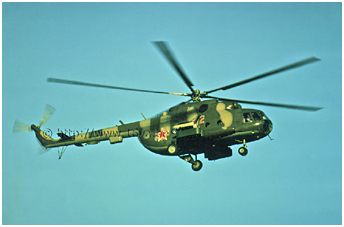 An LPG-150 winch was mounted above the side access door on the left side of the fuselage.
These helicopters were equipped with reinforced fuselage hard points enabling them to support two lateral weapon racks with three weapon pylons. They were thus able to carry
six UB-32A-24 rocket pods (32 57mm S-5 rockets) or only four B-8V20 rocket pods (20 80mm S-8 rockets) or an assortment of ZAB or OFAB bombs.
The Mi-8MT could also mount GUV (Gondola Universal'naya Vertoletnaya - Universal Helicopter Pod - 9-A-669) pods configured in two versions.
The GUV-8700 mounted a YaKB-12.7 (9-A-624) 12.7mm four-barrel gun and two 7.62mm GShG-7.62 (9-A-622) machine guns, while
the GUV-1 was configured with a 30mm AGS-17 Plamya (Flame) automatic grenade launcher. The weapon panoply also included UPK-23-250 cannon pods equipped with 23mm twin-barrel GSh-23L
guns supplied with 250 rounds of ammunition.
Minelaying was also one of the missions the Mi-8MT had to perform, using the VSM-1 or VMR-2 systems as discussed in the second part of this chapter.
An LPG-150 winch was mounted above the side access door on the left side of the fuselage.
These helicopters were equipped with reinforced fuselage hard points enabling them to support two lateral weapon racks with three weapon pylons. They were thus able to carry
six UB-32A-24 rocket pods (32 57mm S-5 rockets) or only four B-8V20 rocket pods (20 80mm S-8 rockets) or an assortment of ZAB or OFAB bombs.
The Mi-8MT could also mount GUV (Gondola Universal'naya Vertoletnaya - Universal Helicopter Pod - 9-A-669) pods configured in two versions.
The GUV-8700 mounted a YaKB-12.7 (9-A-624) 12.7mm four-barrel gun and two 7.62mm GShG-7.62 (9-A-622) machine guns, while
the GUV-1 was configured with a 30mm AGS-17 Plamya (Flame) automatic grenade launcher. The weapon panoply also included UPK-23-250 cannon pods equipped with 23mm twin-barrel GSh-23L
guns supplied with 250 rounds of ammunition.
Minelaying was also one of the missions the Mi-8MT had to perform, using the VSM-1 or VMR-2 systems as discussed in the second part of this chapter.
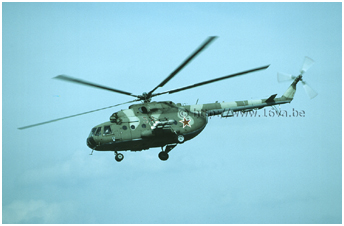
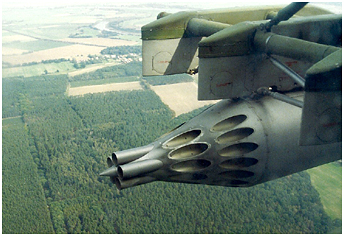 The Afghan conflict brought the Mi-8MT production to the forefront in the mid-1980s. As explained in the first part of this chapter, the Mi-8T and Mi-8MT were adapted
to carry additional weapons during that war. In addition to the optional PKT nose machine gun, one or two pairs of supplementary Kalashnikov PKTs could be attached above the weapon pylons.
Heavy-duty NSV-12.7 Utes (cliff) 12.7mm machine guns or 30mm ASG-17 grenade launchers could also be mounted in the opening of the left side door
or in the opening of the right rear clamshell door hatch - the Mi-8MT's latter was larger than on the Mi-8T. However, these weapons were never
observed in the GDR.
On the other hand, the PZU air intake filters and the ASO-2V-02 flare launchers
developed for Afghanistan became standard equipment. Four of them (two facing left and two facing right), each loaded with 32 26mm magnesium cartridges,
were attached using metal straps under the tail boom.
The Afghan conflict brought the Mi-8MT production to the forefront in the mid-1980s. As explained in the first part of this chapter, the Mi-8T and Mi-8MT were adapted
to carry additional weapons during that war. In addition to the optional PKT nose machine gun, one or two pairs of supplementary Kalashnikov PKTs could be attached above the weapon pylons.
Heavy-duty NSV-12.7 Utes (cliff) 12.7mm machine guns or 30mm ASG-17 grenade launchers could also be mounted in the opening of the left side door
or in the opening of the right rear clamshell door hatch - the Mi-8MT's latter was larger than on the Mi-8T. However, these weapons were never
observed in the GDR.
On the other hand, the PZU air intake filters and the ASO-2V-02 flare launchers
developed for Afghanistan became standard equipment. Four of them (two facing left and two facing right), each loaded with 32 26mm magnesium cartridges,
were attached using metal straps under the tail boom.
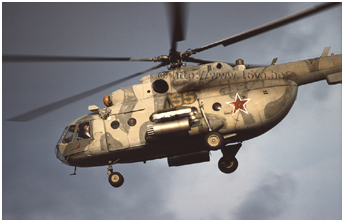
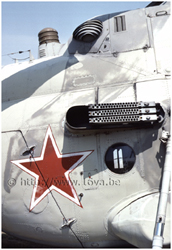 The second half of the 1980s saw the arrival of a new "Hip" version. Its designation was Mi-8MTV (MTV for Modernizerovannyy Transportnyy Visotnyy , Transport, Modernized, High-Altitude).
The new 2000hp TV3-117VM turbines that powered this Mi-8 variant enabled it to take off and land at altitudes up to 4000 meters, while
level flight was possible up to 6000 meters. The maximum power of 2200hp could only be used when one of the two turbines was shut down.
Production of the Mi-8MTV (Mi-17-1V for export) began at Kazan' in 1988, while the Ulan-Ude plant started production in 1991 with the designation Mi-8AMT (Mi-171 for export).
The second half of the 1980s saw the arrival of a new "Hip" version. Its designation was Mi-8MTV (MTV for Modernizerovannyy Transportnyy Visotnyy , Transport, Modernized, High-Altitude).
The new 2000hp TV3-117VM turbines that powered this Mi-8 variant enabled it to take off and land at altitudes up to 4000 meters, while
level flight was possible up to 6000 meters. The maximum power of 2200hp could only be used when one of the two turbines was shut down.
Production of the Mi-8MTV (Mi-17-1V for export) began at Kazan' in 1988, while the Ulan-Ude plant started production in 1991 with the designation Mi-8AMT (Mi-171 for export).
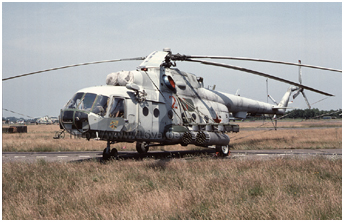
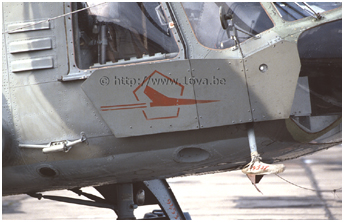 This new version of the Mi-8 based on the Afghan conflict experience was designated Mi-8MTV-2 by the military
(the equivalent civilian version was known as Mi-8MTV-1). These new "Hip-H" were equipped with an armored cockpit comprising internal and external shields.
The latter were two removable lateral plates located on each side of the nose (2).
The overall resistance to damage of this "Hip" version was superior; vital elements such as the tail rotor transmission were better protected, while the fuel tanks were
self-sealing. The survivability of this helicopter was further enhanced by the installation of a SOEP-V1A Lipa (Linden Tree) IR jammer that was placed on a support behind the rotor,
at the root of the tail boom; however, the jammer was not systematically mounted in peacetime. It should be noted that the Mi-8MT based in the GDR also had the provision for a
Lipa but they were never mounted. Like the Mi-8MT, the MTV-2 model was equipped with a SRO-1P "Parol'"(Password) IFF system. The latter could be identified thanks to its
two small triangular antennas located under the nose and under the tail.
This new version of the Mi-8 based on the Afghan conflict experience was designated Mi-8MTV-2 by the military
(the equivalent civilian version was known as Mi-8MTV-1). These new "Hip-H" were equipped with an armored cockpit comprising internal and external shields.
The latter were two removable lateral plates located on each side of the nose (2).
The overall resistance to damage of this "Hip" version was superior; vital elements such as the tail rotor transmission were better protected, while the fuel tanks were
self-sealing. The survivability of this helicopter was further enhanced by the installation of a SOEP-V1A Lipa (Linden Tree) IR jammer that was placed on a support behind the rotor,
at the root of the tail boom; however, the jammer was not systematically mounted in peacetime. It should be noted that the Mi-8MT based in the GDR also had the provision for a
Lipa but they were never mounted. Like the Mi-8MT, the MTV-2 model was equipped with a SRO-1P "Parol'"(Password) IFF system. The latter could be identified thanks to its
two small triangular antennas located under the nose and under the tail.
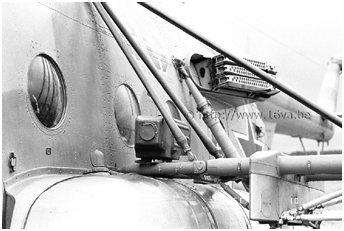
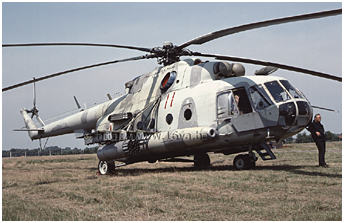 The ASO-2V flare launchers were either attached under the tail boom or, on helicopters of later production batches, housed inside
two forward-inclined aerodynamic fairings located on each side of the fuselage flanks (three launchers per fairing).
It should be noted that these modifications adopted on the Mi-8MTV-2 series were previously retrofitted to varying degrees on previous versions of the Mi-8 operating in Afghanistan.
Helicopters based in the GDR did not carry the optional Kontur (Contour) weather radar nor the nose machine gun.
Also, all Mi-8M observed in East Germany were equipped with beveled exhaust nozzles that prevented a prospective mount of EVU exhaust gas diluters.
S-24 air-to-ground unguided rockets and R-60 air-to-air missiles were tested with at least one Mi-8MTV-2 in Afghanistan
(> Photo). However, these types of weapons were not observed in the GDR.
Since the Mi-8MTV-2 carried only four B-8V20 rocket pods in order to keep good flying qualities, the third weapon pylon was sometimes removed from some "Hip-H" based in Germany.
The ASO-2V flare launchers were either attached under the tail boom or, on helicopters of later production batches, housed inside
two forward-inclined aerodynamic fairings located on each side of the fuselage flanks (three launchers per fairing).
It should be noted that these modifications adopted on the Mi-8MTV-2 series were previously retrofitted to varying degrees on previous versions of the Mi-8 operating in Afghanistan.
Helicopters based in the GDR did not carry the optional Kontur (Contour) weather radar nor the nose machine gun.
Also, all Mi-8M observed in East Germany were equipped with beveled exhaust nozzles that prevented a prospective mount of EVU exhaust gas diluters.
S-24 air-to-ground unguided rockets and R-60 air-to-air missiles were tested with at least one Mi-8MTV-2 in Afghanistan
(> Photo). However, these types of weapons were not observed in the GDR.
Since the Mi-8MTV-2 carried only four B-8V20 rocket pods in order to keep good flying qualities, the third weapon pylon was sometimes removed from some "Hip-H" based in Germany.
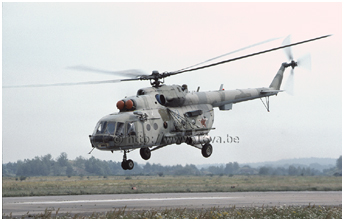
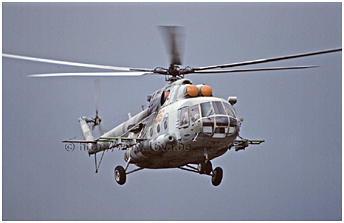 The Mi-8MT would have been introduced within the GFSG in 1977 at Stendal, other sources mentioning the year 1983.
By the time the withdrawal of the Russian troops from the Western Group of Forces had come, the two second-generation Mi-8M variants were far from completely replacing the
first-generation Mi-8T and Mi-8TV. The 239.OGVP at Oranienburg was a bit of an exception, as its last Mi-8T left the unit in the fall of 1990, replaced by a mixed batch of Mi-8MT and MTV-2.
The Mi-8MT would have been introduced within the GFSG in 1977 at Stendal, other sources mentioning the year 1983.
By the time the withdrawal of the Russian troops from the Western Group of Forces had come, the two second-generation Mi-8M variants were far from completely replacing the
first-generation Mi-8T and Mi-8TV. The 239.OGVP at Oranienburg was a bit of an exception, as its last Mi-8T left the unit in the fall of 1990, replaced by a mixed batch of Mi-8MT and MTV-2.
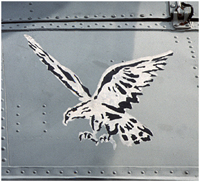 Quelques Mi-8MTV-2 du premier escadron du 487.OVP BU de Werneuchen arboraient un oiseau au-dessus de la porte d'accès latérale. © H.Mambour
Quelques Mi-8MTV-2 du premier escadron du 487.OVP BU de Werneuchen arboraient un oiseau au-dessus de la porte d'accès latérale. © H.Mambour
A few Mi-8MTV-2 of the first squadron from the 487.OVP BU based at Werneuchen had a bird painted above the lateral access door. © H.Mambour
But in 1989 the economic situation forced the Soviet Ministry of
Defense to stop deliveries of Mi-8MTV, at least to regiments stationed in Germany (3).
Most Armeyskaya Aviatsiya units of the GSFG and later the WGF had mixed batches of second- and first-generation "Hip," including outdated helicopters such as
the Mi-8TV that were still on strength in 1990.
With the gradual withdrawal of helicopter squadrons and regiments, the best helicopters often were redistributed to units that were to remain in Germany for a few more months.
An obvious example was the 113.OSAE at Sperenberg; Mi-8MTV-2 from other squadrons replaced all its Mi-8Ts.
Since these helicopters were tasked with the transport of officers,
their external armor plates and even the weapon racks were dismantled to improve the Mi-8 performance.
notes
(1)
The Mi-8M, Mi-14 and Mi-24 were powered by different versions of the TV3-117 turbine.
(2)
En RDA, on reconnaissait aisément les Mi-8MTV-2 grâce aux plaques de blindage externes. Il existait toutefois un autre moyen de distinguer un Mi-8MT d'un Mi-8MTV-2 en examinant les antennes
situées au-dessus de la poutre de queue : les Mi-8MT disposaient d'une antenne fine et d'une antenne lame, tandis que les Mi-8MTV-2 étaient équipés de deux antennes lame. Jusqu'à preuve du
contraire, aucune exception n'a jamais été observée au sein du GFSA.
(3)
Information based on the article of Stefan Büttner entitled "Beginning of the end" published in the November 2009 issue of "Aircraft" magazine.
 |
The Mi-8 < Part 1 | < Part 2 | > Part 4 | > Part 5 | > Part 6 | > Part 7 |
 |
Plan du site - Sitemap |  |


